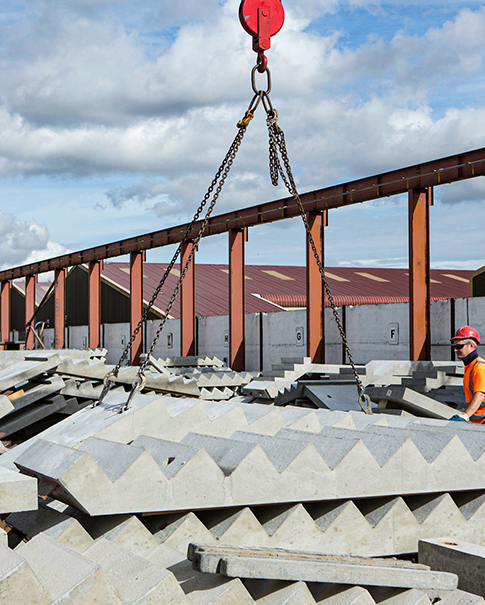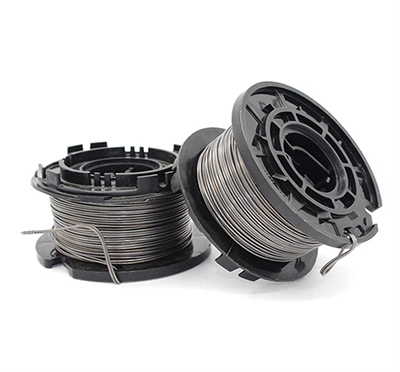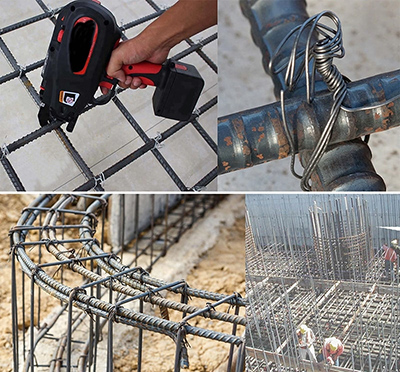-

Envoyez-nous un courriel
sale@lscmagnetics.com -

Numéro de contact
+86 -13559234186

Envoyez-nous un courriel
sale@lscmagnetics.com
Numéro de contact
+86 -13559234186
Comment choisir le bon fil de fer à béton pour différents projets de construction ?
Oct 23, 2025Sur les chantiers de construction grandioses, nous sommes souvent captivés par les imposantes structures en acier ou les murs en béton coulé sur place, mais nous prêtons rarement attention aux « fils » qui relient étroitement d'innombrables barres d'armature : les tirants. Bien que petits, ces fils sont essentiels à la stabilité et à la fiabilité du « squelette » d'un bâtiment. Choisir les mauvais tirants peut, au mieux, compromettre l'efficacité de la construction et, au pire, engendrer des risques pour la sécurité. Alors, comment choisir les meilleurs tirants pour différents projets de construction ? Cet article vous expliquera en détail.


I. Compréhension Fil d'armature: Plus qu'un simple « fil »
Le fil d'armature est généralement fabriqué en acier bas carbone, recuit pour une plus grande flexibilité et souvent galvanisé (électro-galvanisation ou galvanisation à chaud) pour prévenir la rouille. Sa fonction principale est de relier solidement les intersections des treillis ou des nervures des barres d'armature avant le coulage du béton, garantissant ainsi le bon positionnement et la stabilité globale de la barre dans le béton.
Exigences de performance de base :
Résistance à la traction suffisante : résiste aux forces de traction pendant le processus de liaison et aux perturbations ultérieures pendant la construction sans se rompre.
Bonne flexibilité : permet un pliage et un enroulement faciles, facilitant la manipulation par les travailleurs et améliorant l'efficacité.
Excellente résistance à la corrosion : le revêtement en zinc empêche efficacement la rouille, en particulier dans les environnements humides, ouverts ou corrosifs, garantissant l'efficacité à long terme de la cravate.
Correspondance des spécifications : Le diamètre du fil doit correspondre au diamètre et aux conditions de charge de la barre d'armature liée.
II. Considérations clés pour le choix du fil de liaison
Avant de sélectionner un fil de liaison pour un projet spécifique, vous devez d’abord clarifier les questions clés suivantes :
A. Type de structure et importance : S'agit-il d'un immeuble résidentiel ordinaire, d'une centrale nucléaire ou d'un pont maritime ? Les structures critiques nécessitent une durabilité accrue du fil de liaison.
B. Conditions environnementales : Le bâtiment est-il situé dans un espace intérieur sec, un environnement humide, une zone côtière ou une zone industrielle fortement polluée par des produits chimiques ? La corrosivité de l’environnement détermine le niveau de protection antirouille requis.
C. Spécifications et espacement des barres d'armature : les barres d'armature épaisses et les treillis d'armature denses nécessitent un fil de liaison plus épais et plus résistant pour fournir une force de maintien suffisante.
D. Efficacité et coût de construction : les différents fils de liaison ont des prix et une facilité d'installation différents, il faut donc trouver un équilibre entre performance et rentabilité.
III. Comment sélectionner avec précision les cravates en fonction du type de projet ?
Les différents projets de construction présentent des caractéristiques structurelles, des spécifications de barres d'armature, des exigences de charge et des environnements de construction très différents, ce qui entraîne des exigences variables en matière de fils de liaison.
A. Construction résidentielle et commerciale : spécifications standard, priorité à l'efficacité
Caractéristiques : Les spécifications des barres d'armature sont relativement uniformes (généralement Φ12-Φ25 mm), la structure se compose principalement de poutres, de dalles et de colonnes, et le volume de construction est élevé, l'accent étant mis sur l'efficacité.
Sélection de fils de liaison :
Spécifications : Pour les poutres, les poteaux et les dalles de la structure principale, il est recommandé d'utiliser des fils d'armature d'un diamètre de 2,2 à 2,5 mm (calibre 13-12 environ). Ils offrent un équilibre optimal entre résistance et efficacité, garantissant une fixation solide de l'armature principale sans les difficultés de manipulation dues à des fils trop épais.
Type : Pour les environnements intérieurs secs, un fil d'attache électrozingué, plus économique, peut être utilisé. Pour les zones exposées, comme les balcons et les toits, susceptibles d'être exposés aux eaux de pluie, un fil d'attache galvanisé à chaud, plus résistant à la corrosion, est recommandé. Conditionnement : Pour une efficacité accrue, des pinces coupantes en U ou des attaches à anneaux prédécoupées peuvent être utilisées afin de réduire le temps de coupe des fils sur site.
B. Ingénierie des ponts : un projet d'un siècle, sécurité et fiabilité
Caractéristiques : En tant que projets de lignes de vie, les ponts exigent des exigences de sécurité et de durabilité extrêmement élevées. Ils sont dotés de barres d'armature de grand diamètre, de charpentes lourdes et sont exposés à des environnements difficiles et à des charges dynamiques pendant de longues périodes.
Sélection de fils de liaison :
Spécifications : Pour le renforcement principal du pont (souvent plus grand que Φ25 mm) et les joints critiques, un fil de liaison plus épais doit être utilisé pour garantir des connexions sécurisées. φ3,2 mm - φ4,0 mm (n° 10-8) est recommandé.
Type : Le fil d'attache galvanisé à chaud doit être utilisé. Son revêtement de zinc plus épais offre une protection anticorrosion de plusieurs décennies et est adapté aux environnements extérieurs difficiles tels que l'humidité et les embruns (notamment pour les ponts transfrontaliers).
Normes : Les normes nationales (telles que GB/T 343) doivent être strictement respectées. La certification des matériaux doit être vérifiée à la livraison afin de garantir que la résistance à la traction et l'épaisseur du revêtement de zinc sont conformes aux normes.
C. Tunnels et projets souterrains : humides et fermés, la prévention de la corrosion est essentielle
Caractéristiques : Les environnements souterrains sont humides, même avec des eaux souterraines, et ont une mauvaise ventilation, ce qui exerce une pression importante sur la résistance à la corrosion des matériaux.
Sélection de fils de liaison :
Spécifications : Des fils d'armature de 2,0 à 3,2 mm de diamètre peuvent être sélectionnés avec souplesse, en fonction du support principal du tunnel (par exemple, treillis métallique avec des barres d'acier plus fines) et du revêtement secondaire (structure principale avec des barres d'acier plus grossières). Par exemple, un diamètre de 2,0 mm peut être utilisé pour le treillis métallique, tandis qu'un diamètre de 2,5 mm ou plus peut être utilisé pour l'armature principale.
Type : La galvanisation à chaud est l’exigence minimale. Dans les formations riches en ions corrosifs (par exemple, les formations de roches salines et sulfurées), des fils d’attache revêtus de PVC peuvent être envisagés. Ce revêtement plastique offre une barrière chimique supplémentaire, isolant complètement le fil de l’environnement agressif.
D. Projets de conservation de l'eau : une terre d'eau, procédez avec prudence
Caractéristiques : Les ouvrages tels que les écluses, les stations de pompage et les réservoirs sont en contact permanent avec l’eau. Certaines structures (par exemple, les digues et les canaux) peuvent également être corrodées par les ions chlorure (eau de mer). Choix du fil d’attache :
Spécifications : Les tailles courantes des barres d'armature pour les projets hydrauliques varient de 8 à 22 mm, donc le fil d'attache de 2,0 à 2,5 mm de diamètre est le plus largement utilisé.
Type : La galvanisation à chaud est la norme. Pour les structures sous-marines critiques ou les projets côtiers, le fil revêtu de PVC constitue également une option plus fiable, résistant aux environnements difficiles caractérisés par des cycles humides-secs prolongés et la corrosion par les ions chlorure.
Enfin, quelques conseils de construction et idées fausses courantes.
* Vous préférez les attaches épaisses aux attaches fines ? Pas forcément : les attaches trop épaisses sont non seulement coûteuses, mais aussi difficiles à plier et à serrer, ce qui peut entraîner des desserrages, voire des accrochages pour les ouvriers. Il est essentiel de respecter les spécifications des barres d'armature.
* Des attaches plus serrées ne sont pas toujours la meilleure solution : un serrage excessif peut entraîner l'étirement, voire la rupture, des attaches, ou endommager le revêtement galvanisé des barres d'armature. Des attaches solides et stables suffisent.
* Vérifiez la présence de rouille : les attaches fortement rouillées doivent être strictement évitées, car leur résistance est considérablement réduite et elles continueront à rouiller dans le béton, affectant leur force de liaison.
* Faites attention aux normes : choisissez des produits conformes aux normes nationales (telles que la GB/T chinoise) ou aux spécifications de l'industrie pour une meilleure assurance qualité.
ÉTIQUETTES :